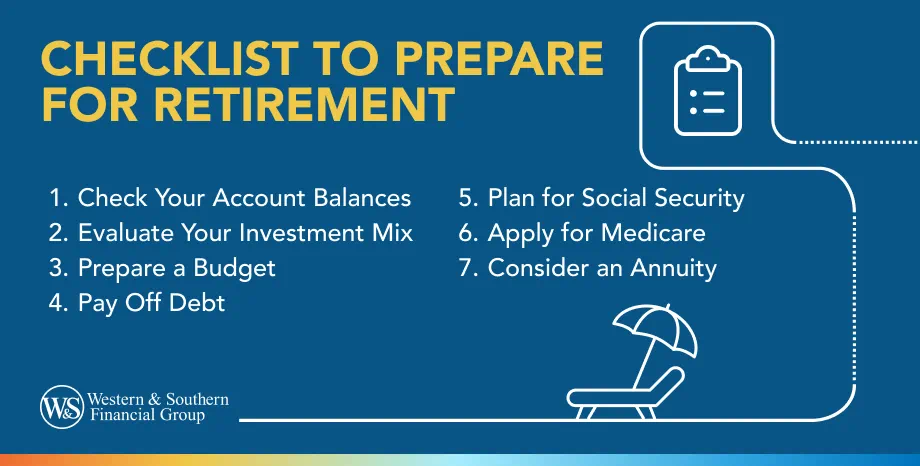

Key Takeaways
- Assess your account balances and save enough to sustain your preferred retirement lifestyle, considering factors like lifestyle, location, and taxes.
- Evaluate and adjust your investment mix as you approach retirement, balancing growth potential with risk management.
- Create a budget to manage your expenses and ensure you live within your means during retirement.
- Prioritize paying off debts and consider prepaying mortgage to reduce financial burden in retirement.
- Understand the implications of Social Security, including the choice between early or full retirement age, and potentially delaying benefits for higher payments.
Retirement is supposed to be your reward after decades of hard work. But your ability to enjoy this important stage of life could depend in part on how well you've prepared yourself financially.
Hopefully you'll have many years ahead of you when you exit the workforce, which means you'll need adequate resources to help sustain your health and happiness. The following retirement checklist could help you prepare for retirement financially.
1. Check Your Account Balances
Many Americans don't have a pension they can rely on in retirement, and Social Security might not cover all your living expenses. In light of this, you might choose to build substantial assets in your savings accounts to help sustain your preferred retirement lifestyle.
How much money you'll need to live on will vary depending on
- your lifestyle
- where you live
- whether your investments will be taxed in retirement, among other things
If you need a rough idea of how much money you'll want to save for retirement, a retirement calculator may help.
2. Evaluate Your Investment Mix
Building a stock-heavy investment portfolio when you're young may help you build gains if those assets perform well. Leaning too much on conservative investments may not provide the growth you need to support yourself over the long haul. However, while diversification might help you manage investment risk, it also does not guarantee a positive outcome from any assets, and these investments do not guarantee growth and may instead lose value over time.
As you get older and approach retirement, evaluate your asset mix to help ensure it's aligned to your investment time frame, financial needs and comfort with volatility. Keep mind that you won't have as much time to recover from a market downturn as when you were younger. So, depending on your individual situation and investment goals, you might consider slowly adjusting your asset mix to incorporate more fixed-income and cash instruments as you get older.
Optimize your investment strategy for a confident retirement. Start Your Free Plan
3. Prepare a Budget
Although some people choose to continue working to some degree, you probably don't want to be forced back into the workforce because you spent more than you could afford in retirement. Therefore, your checklist for retirement could include creating a budget that helps you stay within your means.
Take a look at how much you'll need to spend on housing, food, health care and other necessities. Doing so can help determine how much you'll need to withdraw every month from your investment and savings accounts in order to cover these expenses. Today, there are a host of mobile apps to help with budgeting.
4. Pay Off Debt
You may have significantly less income in retirement than you had during your working years. When you're counting your dollars more carefully, you might not want to have to make loan payments.
Before you retire, think about paying down credit cards and high-interest rate debts to give yourself some breathing room. If your mortgage doesn't have a prepayment penalty, speeding up your repayment can be another good way to free up some of your retirement budget.
5. Plan for Social Security
If you're eligible for Social Security benefits, you can start to receive payments as early as age 62. However, it's important to keep in mind that your monthly benefit amount will be reduced if you start to collect payments before your full retirement age, which is between ages 66 and 67, depending on your birth year.1 You'll want to consider whether it makes more sense for you to collect early or to wait until your full retirement age.
If you're healthy and expect to live a relatively long life, you may want to hold out even longer than your full retirement age. The amount of your payment increases for each month you delay benefits until you reach age 70.2
6. Apply for Medicare
For a lot of Americans, leaving your job means leaving your employer's health care coverage behind. If you're 65 or older, one way to prepare for retirement is to sign up for Medicare, which can be less expensive than buying private insurance without employer sponsorship.
One category that Medicare normally doesn't cover is nursing homes and assisted living stays. Long-term care insurance is designed to help you pay for these costs, so it may be worth looking into such a policy as you near retirement or earlier.
7. Consider an Annuity
To help prevent outliving your retirement funds, consider converting part of your financial assets into a fixed annuity. These insurance contracts provide you with regular payments for either a certain number of years or for your entire lifetime. If you purchase a deferred annuity, which delays payments until a later date, you'll typically be able to receive a larger payout each month.
Planning your retirement is an exciting process, but it's also one that you'll want to undergo thoughtfully. Talking to a financial representative about your needs can help as you prepare for retirement.
Organize your retirement checklist for a structured path to your goals. Start Your Free Plan
Sources
- Starting Your Retirement Benefits Early. https://www.ssa.gov/benefits/retirement/planner/agereduction.html.
- Delayed Retirement Credits. https://www.ssa.gov/benefits/retirement/planner/delayret.html.





























